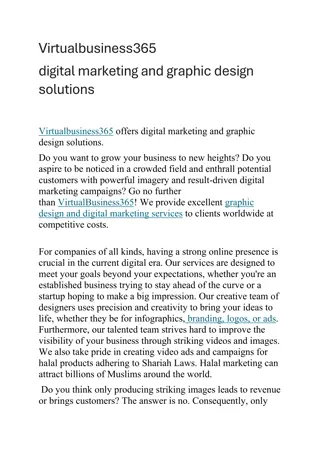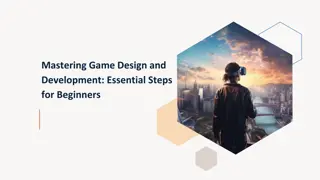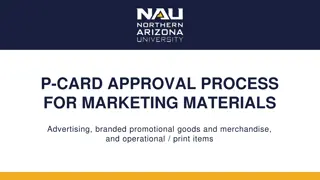Game Design Lesson: Press Materials and Website Marketing Tips
Explore the world of game marketing through press materials, websites, and digital playtesting. Dive into UI design considerations, enhancing game feel, and UI design samples for a comprehensive understanding.
Download Presentation

Please find below an Image/Link to download the presentation.
The content on the website is provided AS IS for your information and personal use only. It may not be sold, licensed, or shared on other websites without obtaining consent from the author. Download presentation by click this link. If you encounter any issues during the download, it is possible that the publisher has removed the file from their server.
E N D
Presentation Transcript
Game Design LESSON #13: Game Marketing #1: Press Materials and Websites
TODAY: 1. Team Meetings 2. Game Feel Brainstorming 3. UI Design Considerations 4. Team Peer Digital Playesting 5. Game Marketing Considerations: Internet Tools, Social Media, Conferences, and Press.
PART 1: DIGITAL PLAYTESTING SET UP (<5 minutes): 1. Teams Choose Tables 2. Set up game digital prototype on 2-3 laptops. 3. Decide initial Observers (1-2) and Players. 4. Discuss: Do you want 1-3 points/ instructions to share with visiting players? Write them down!
PART 1: DIGITAL PLAYTESTING PLAYTEST ROUND (20 minutes): 1. Observers stay to manage playtest, Players find other games to play. 2. If team chose 1-3 instructions, give them. 3. Players attempt to play prototype (5-10 min). Observers take notes! 4. Players fill out questionnaire (5 minutes). 5. Time permitting, discuss answers.
PART 2: Game Feel What are ways for the game to tell the player they have been hit? How do we make an interaction (player action, game action, response) more JUICY? Watch the short Game Feel Techniques video. What do you think of these ideas? The Juice it or Lose it video talks about making super extreme intense juiciness getting the blood pumping, making people want to move their bodies in intense ways to play the game. What are ways to add gentle-juice elements that cause a calming, in-the-flow Feel? Brainstorm with your team: What are 20 ways to enhance your game with game-feel elements? What interactions most need to be enhanced / emphasized? What would help your game feel increasingly good to play?
PART 3: UI Design Considerations Take a look at all framing scenes, buttons, and HUD elements. Pay close attention to the Game Logo. Look for consistency in style between these elements, and what they communicate about the game genre, level of play difficulty and overall intended mood. Include a buffer around text or icons, and consider creating an outline (stroke) around elements to help them stand out. Other ways to distinguish HUD elements from the background include contrasting hue, value, or brightness (saturation). Avoid tangents: places where lines touch instead of clearly overlapping or being clearly separated. NOTE: A brutally hard game will typically not have a light bubble-gum style; the mismatch can confuse players (even if the notion that bubblegum is not hard core is itself socially constructed)
PART 3: UI Design: Samples Consider this UI set from a student game, including Title and end-screen text, all custom drawn to look consistent. Also a slider-jewel, and HUD background images for buttons and player health. Take time this week to try a UI pass, to help your game look more polished!
PART 3: UI Design: Framing Scenes Your intro scenes can pull a player into your world! Consider these screens from a team that made a rock musician battle game, with all elements intended to feel like guerrilla marketing:
PART 3: UI Design: Framing Scenes Your intro scenes can pull a player into your world! Consider these screens from a team that made a rock musician battle game, with all elements intended to feel like guerrilla marketing:
PART 3: UI Design: Framing Scenes Your intro scenes can pull a player into your world! Consider these screens from a team that made a rock musician battle game, with all elements intended to feel like guerrilla marketing:
PART 4: DIGITAL PLAYTESTING SET UP (<5 minutes): 1. Teams Choose Tables 2. Set up game digital prototype on 2-3 laptops. 3. Decide initial Observers (1-2) and Players. 4. Discuss: Do you want 1-3 points/ instructions to share with visiting players? Write them down!
PART 4: DIGITAL PLAYTESTING PLAYTEST ROUND (20 minutes): 1. Observers stay to manage playtest, Players find other games to play. 2. If team chose 1-3 instructions, give them. 3. Players attempt to play prototype (5-10 min). Observers take notes! 4. Players fill out questionnaire (5 minutes). 5. Time permitting, discuss answers.
PART 4: DIGITAL PLAYTESTING: What to Cut? With 2 weeks of production left this term, now is a good time to have the hard conversations with your team: What features are you willing to work to push through, and what can you cut?
PART 5: GAME MARKETING The Marketing requirements for this course are to make a Website (wix.com or weebly.com) with: 1. Game Logo 2. itch.io or PC/Mac download Links 3. Gameplay Trailer (~40-60 seconds) 4. Game Screenshots (3-6) 5. Team Pics & Bios (professional links encouraged) 6. Press Release / Game Description
PART 5: GAME MARKETING Your website and trailer can be earnest, straight-forward explanations of your game contents and its creators, branded with the UI color and shape themes from the game. Alternatively they can be immersive parts of your game world. Consider the provided websites and videos for Red vs Blue (2017) and Midnight Cleaning Company (2020). What makes these two very different presentations appealing?
PART 5: GAME MARKETING Programmers, artists, and designers usually tolerate or even don t like dealing with marketing. Part of the issue is that marketing takes a very different set of skills than other areas of game development: regular contact with large numbers of people, rather than just with the small team. Working with the greater unknowns of audience reaction rather than the more predictable development tasks of following the development plan.
PART 4: GAME MARKETING BUT: Marketing your game can be as fun as making it. Marketing itself is a kind of game: How many people can you reach? How many news-sites or blogs or tweeters or other outlets can you get to pay attention to your work? What new, fun, creative and exciting ways can you CELEBRATE the achievement that is your game?
Question: What is Marketing? Identifying, reaching, and cultivating an AUDIENCE for your product and organization. Creating MEDIA which communicates the intent of your product (designed for your audience). Collaborating with other organizations to reach your audience in new ways. Establishing a PRESENCE for your audience to find your product. HAVING FUN with your product!
Question: How important is Marketing your game? Or, put another way: what percentage of game development should be spent on marketing the game?
Question: How important is Marketing your game? 50%
Question: What are the Game Marketing roles?
Question: What are the Game Marketing roles? Marketing Lead: Designs strategy, directs marketing team, analyzes analytics, manages budget and makes reallocation decisions. Content Development: Writes press releases, blog posts, promotions and other communications. Arranges for art and other materials from the development team. Community Manager: Attends to company forums and other social networking sites (Facebook, Twitter, etc) to keep audience engaged with prompt answers and frequent content. Show Manager: Plans and attends gamer and industry events to promote the game to audience and press. Works with conference managers, designs and manages Booth, giveaways and other promotions. In all but the biggest companies this is managed by other team members and sometimes elements are outsourced. and others. Sometimes in a small studio this is all one person!
MARKETING YOUR GAME #1: MAKE A PLAN. [a]. Research [b]. Market Alongside Game Development [c]. Marketing is a numbers game [d]. Money vs Sweat
MARKETING YOUR GAME #1: MAKE A PLAN. [a]. Research: Who is your audience? How do they find the games they play? What are ways you can reach them? What are ways you can maintain contact with them to promote loyalty to your company/product, so they want updates, your next game, and to tell others about your game?
MARKETING YOUR GAME #1: MAKE A PLAN. [b]. Market Alongside Game Development: While marketing will continue long past the time the gam has released, a good marketing team cam build attention to the game a hungry audience for more than a year before it is released with early trailers, beta programs, builds, contests, crowdfunding, user generated content, and other teasers.
MARKETING YOUR GAME #1: MAKE A PLAN. [c]. Marketing is a numbers game. Do you devote a lot of resources to getting a few influential people to notice/promote your game or do you spend time/money/effort reaching out to a much larger number of lower-influence media people? Or a mix?
MARKETING YOUR GAME #1: MAKE A PLAN. [d]. Money vs Sweat: Do you have a significant budget to promote your game through online and real world ad buys and purchased reviews, or do you need to work that much harder, talk to so many more people, to get the word out that your game exist and it is awesome?
MARKETING YOUR GAME #2: ADJUST YOUR PLAN. ANALYTICS: It used to be hard to know exactly how much the location of an ad buy or the exact language used had how much of an affect on the intended audience, but these days with online analytics tools for your website and game we get amazingly granular information about exactly what people do or do not do with our advertisements. Do they click or not? How many pages on your site do they view before they leave? Do they play your tutorial in your game? How far in the game before they quit? What parts of the game do they see and what do they do? How long is each play session? Any aspect of play or progress an be measured with a hook set by the Marketing lead to analyze player activity and to inform changes for a more enjoyable user experience. Marketing leads will typically spread a budget across multiple online campaigns, review the analytics data from each, and then devote more resources to the campaigns that get the best results.
PRESS: Tell a Story Who should you contact?: Don t just spam everyone. Research destinations and specific writers to find and cultivate relationships with those writers to write about your game. Why should they care about your project? You have identified writers/etc who are interested in games like your s (style of play, platform, genre) and YOU HAVE A STORY TO TELL If you are a small/new company, your quest with getting members of the press (established gamer sites, bloggers in your niche, and more general media) is to tell an intriguing story. The American myth of now-great tech giants starting in garages is an example of the Small town kid makes good story. There are heroic journeys and ridiculous situations and heartwarming struggles and all sorts of stories you can map onto the tale of your team s creation and onto how the game itself was made. As a small game developer, you are telling YOUR story as much as the game s!
Crowdfunding: Kickstarter If you are already famous, people you don t know will fund you. If you are not famous, Kickstarter is a decent way to mobilize the people you do know to fund you. In either case, it can be a GREAT way to get press and long-term attention to your project, and TELL YOUR STORY. Here are some particularly memorable (and successful) presentations: Exploding Kittens https://www.kickstarter.com/projects/elanlee/exploding-kittens/description ABBY HOWARD: https://www.kickstarter.com/projects/1203079854/2013-the-last- halloween/description DOUBLEFINE: https://www.kickstarter.com/projects/doublefine/double-fine-adventure/description https://www.kickstarter.com/projects/doublefine/double-fines-massive- chalice/description
WEB PRESENCE Website:Does anything exist if it isn t online? Tumblr or wordpress or wix for free CMS, or a custom site (annual URL cost + hosting fee). Blog: Share news and updates to help make your company look lively! Show parts of the game, teasers, explain tools with tutorials: engage your audience and other developers! Don t forget to make your posts more discoverable with tags. Forums: Get your community to meet each other and share excitement about your game! Can start as a place where tips about gameplay are available. Giveaways: Desktop wallpapers are free! Also papercraft, short stories in your game world, links to related content (making a zombie game? Put up an our favorite zombie movies links list), even cool paper versions/prototypes of your game for people to print out and play! Mailing List: MailChimp or Constant Contact, requires a physical mailing address be shared with subscribers. Tools for managing communication with subscribers, helps to grow and hold onto an audience!
WEB PRESENCE: Connect to your audiences interests Blizzard Entertainment, 2015
WEB PRESENCE: Connect to your audience s interests Blizzard 2020: What changes did they make, and how do they reflect a change of audience focus?
WEB PRESENCE: Connect to your audiences interests Riot Games, 2015
WEB PRESENCE: Connect to your audience s interests Riot 2020: What changes did they make, and how do they reflect a change of audience focus?
WEB PRESENCE: Connect to your audiences interests Bethesda, 2015
WEB PRESENCE: Connect to your audience s interests Bethesda 2020: What changes did they make, and how do they reflect a change of audience focus?
WEB PRESENCE: Connect to your audiences interests FableVision, 2015
WEB PRESENCE: Connect to your audience s interests FableVision 2020: What changes did they make, and how do they reflect a change of audience focus?
WEB PRESENCE: Connect to your audiences interests 77 Sparx, 2015
WEB PRESENCE: Connect to your audiences interests Double Fine Games, 2015
WEB PRESENCE: Connect to your audiences interests Monument Valley, 2015
SOCIAL MEDIA You know what this is: Create regular content and engage in multiple audiences Facebook: Update multiple times a week. Twitter: Update multiple times a day. Use hashtags, direct messages, retweeting. Follow people in the industry and the PRESS: organizations and individual writers! Instagram, Pintrest, Google+, etc
MANAGE YOUR STORE Participate in promotions like Humble Bundle, offer sales related to holidays, adjust your store language and tags with new builds, upload new builds with meaningful new content as often as your team can helps with store rankings, also offers new content for contacting all of the press, all over again! ADVERTISING Facebook and Google Ads allow for targeted games, with decent success rates when promoting a free (lite?) version of your game. End the game with promotion to buy the full game, or get on a mailing list for more great games. Also consider even more targeted ads on specific sites, publications, and public spaces, GRASS ROOTS ORGANIZING Making a kids game? Reach out to Momblogs, post flyers in parent gathering places, submit to mom forums and mailing lists. Owlchemy Labs sent an employee to a logging competition/festival in the Midwest to advertise their Jack Lumber game. Reach out to new communities to create new audiences for your game!
MEET YOUR PUBLIC: CONFERENCES Meet and engage your audience and press at Gamer Conferences like PAX, SXSW, E3, BFIG, Comicon, and many other regional events including some more specific to particular genre, age range, etc. Meet Press and potential collaborators at Professional Conferences like GDC, Sandbox Summit, and local networking events. Give talks to get more attention to your work and games! Participate in panels, offer giveaways to your twitter followers. Attend parties to meet more people! Get a Booth: costs $$, so share with others. Consider Kelly Wallick s Indie Megabooth
ENTER CONTESTS AND FESTIVALS Like crowdfunding, a successful entry in a contest or a festival (Indies can get free booths if selected for Pax, BFIG, etc) can pay off huge dividends for attracting the attention of press and your audience. Research and submit to many contests, not just gaming ones! PAID CONTESTS: BRAGGING RIGHTS CONTESTS: Ludum Dare TIGSource Experimental Gameplay Project The Global Game Jam Retro Remakes The Daily Click Game Prototype Challenge SHMUP-DEV Something Awful GameCreation Indie Kombat PyWeek GameDev GameJolt The Poppenkast Klik Of The Month Klub GameBuilder IGF Independent Games Festival Unity Game Developer Contest Windows Game Developer Contest IndieCade Indie Game Challenge indiePub Games BIG Festival Dare To Be Digital XNA Dream.Build.Play Imagine Cup Kongregate The Game Creators Intel Contests YoYo Games and more!
COLLABORATIONS AND STUNTS Small Indies need more than anything else to get noticed! Sometimes we resort to stunts. Sometimes it works. John Butler, Yin Yang BANG BANG: http://imgur.com/gallery/rJK7J http://imgur.com/gallery/p3KWi
COLLABORATIONS AND STUNTS Small Indies need more than anything else to get noticed! Sometimes we resort to stunts. Sometimes it works. Ichiro Lambe, Dejobaan Games: Valve/Steam Promotion, advertised on the largest PC gaming portal!
COLLABORATIONS AND STUNTS Small Indies need more than anything else to get noticed! Sometimes we resort to stunts. Sometimes it works. Ziba Scott, Popcannibal Games:























